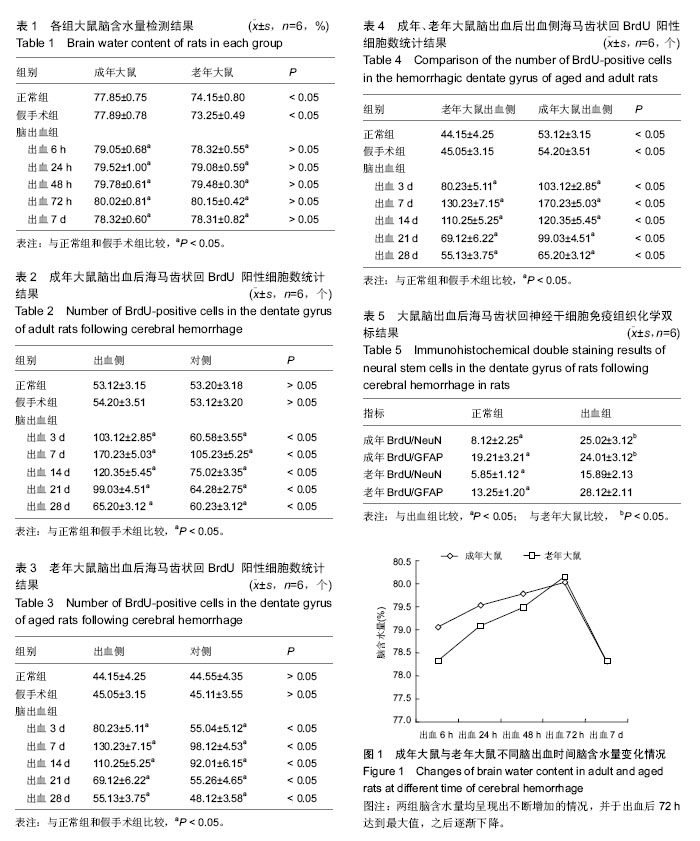| [1] 文玉军,王登科,孙征,等.成年和老年大鼠脑出血后海马齿状回神经干细胞的变化[C].中国解剖学会2011年年会论文集,2011:57-57.
[2] 文玉军,王登科,孙征,等.成年和老年大鼠脑出血后海马齿状回神经干细胞增殖分化的比较[J].中国老年学杂,2012, 32(24):5455-5458.
[3] 王登科.成年和老年大鼠脑出血后海马齿状回神经干细胞增殖及分化的研究[D].宁夏医科大学,2011.
[4] 文玉军,王登科,孙征,等.老年大鼠脑出血后海马齿状回神经干细胞的增殖与分化[J].中风与神经疾病杂志,2011, 28(12):1070-1073.
[5] 彭俊.成体神经干细胞移植治疗大鼠脑出血实验研究[D].中南大学,2013.
[6] 谢逸群.BMP-7和noggin基因对成年大鼠脑出血神经修复的影响[D].中南大学,2004.
[7] 张弩,周辉,杨林,等.成年大鼠海马神经干细胞移植治疗脑出血的研究[J].温州医学院学报,2007,37(1):33-35.
[8] 罗文芳,黎杏群,罗杰坤,等.神经干细胞移植治疗脑出血大鼠模型时间窗的研究[J].中国老年学杂志,2008, 28(7): 625-628.
[9] 王复新,燕飞,毕胜,等.大鼠脑出血微创后行神经干细胞移植对其神经功能的影响[J].中风与神经疾病杂志,2013, 30(11):1012-1015.
[10] 罗文芳.脑出血大鼠神经干细胞移植后IL-2、IL-10的表达及中药干预的影响[D].中南大学,2008.
[11] 刘云峰.神经干细胞的分离培养及移植治疗大鼠脑出血的实验研究[D].山西医科大学,2004.
[12] 罗杰坤.脑溢安对缺氧神经干细胞和大鼠脑出血损伤后活化Caspase-3、磷酸化Akt表达的影响[D].中南大学, 2002.
[13] Chu K,Jeong SW,Jung KH, et al.Celecoxib induces functional recovery after intracerebral hemorrhage with reduction of brain edema and perihematomal cell death. J Cereb Blood Flow Metab.2004;24(8):926-933.
[14] Wakai T,Sakata H,Narasimhan P,et al.Transplantation of neural stem cells that overexpress SOD1 enhances amelioration of intracerebral hemorrhage in mice. J Cereb Blood Flow Metab.2014;34(3):441-449.
[15] 王华,陆芩,诸葛启钏,等.绿色荧光蛋白转基因小鼠神经干细胞在脑出血大鼠脑内移植后迁移和神经功能改变[J].实用医学杂志,2013,29(19):3146-3148.
[16] 毛进鹏,诸葛启钏,刘乐平,等.绿色荧光蛋白转基因神经干细胞脑出血大鼠脑内移植后血管生成与神经形态学的改变[J].中华实验外科杂志,2012,29(4):690-692.
[17] 刘安民,蔡望青,麦荣康,等.大鼠脑出血后内源性神经干细胞激活和增殖的实验研究[J].中华神经医学杂志,2008, 7(10):997-1000.
[18] Qin J,Song B,Zhang H,et al.Transplantation of human neuro-epithelial-like stem cells derived from induced pluripotent stem cells improves neurological function in rats with experimental intracerebral hemorrhage. Neurosci Lett.2013;548:95-100.
[19] 李秋霖,王振忠,方剑波,等.神经干细胞在脑出血大鼠脑内移植后对IL-6、TNF-α表达的影响[J].中华神经外科杂志, 2010,26(3):272-276.
[20] Wang D,Liang JH,Zhang JJ,et al.Mild hypothermia combined with a scaffold of NgR-silenced neural stem cells/Schwann cells to treat spinal cord injury.Neural Regen Res.2014;9(24): 2189-2196.
[21] Dulin JN, Lu P.Bridging the injured spinal cord with neural stem cells.Neural Regen Res.2014;9(3): 229-231.
[22] 任虹宇,李明轩,何承,等.神经干细胞移植脑出血恢复期大鼠神经功能和促血管生成素1及受体的表达[J].中国组织工程研究,2015,(32):5199-5203.
[23] 陈志颖,殷小平,潘超,等.脑出血微创血肿清除术后内源性神经干细胞激活的实验观察[J].内科急危重症杂志,2014, 20(3):188-192.
[24] Khalili MA,Anvari M,Hekmati-Moghadam SH,et al. Therapeutic benefit of intravenous transplantation of mesenchymal stem cells after experimental subarachnoid hemorrhage in rats. J Stroke Cerebrovasc Dis.2012;21(6):445-451.
[25] Aisa Y,Mori T,Nakazato T,et al.Primary central nervous system post-transplant lymphoproliferative disorder presenting as cerebral hemorrhage after unrelated bone marrow transplantation. Transpl Infect Dis.2009; 11(5):438-441.
[26] 汤华军,范光碧,郑宇杰,等.脑出血后大鼠神经干细胞增殖及迁徙途径的实验研究[J].中国临床解剖学杂志,2015, 33(2):189-192.
[27] 唐洲平,康慧聪,彭岚,等.神经干细胞和嗅鞘细胞联合移植与神经干细胞移植治疗实验性脑出血的比较[J].中华神经科杂志,2005,38(8):503-506.
[28] 李峰,刘玉光,朱树干,等.经颈动脉注入神经干细胞治疗脑出血后遗症的时间窗及疗效[J].中华实验外科杂志, 2008, 25(4):474-476,封3.
[29] Fatar M,Stroick M,Griebe M et al.Lipoaspirate-derived adult mesenchymal stem cells improve functional outcome during intracerebral hemorrhage by proliferation of endogenous progenitor cells stem cells in intracerebral hemorrhages. Neurosci Lett.2008; 443(3):174-178.
[30] 唐洲平,彭岚,康慧聪,等.神经干细胞和嗅鞘细胞联合移植改善脑出血大鼠的运动功能[J].中华器官移植杂志,2005, 26(5):303-306.
[31] 高鲁.脑出血大鼠神经干细胞移植对调节性T细胞和γδT细胞及其相关因子的调节作用[D].温州医科大学,2014.
[32] 卢旺盛,田增民,赵全军,等.立体定向神经干细胞移植治疗脑出血后遗症疗效分析[J].中华神经外科疾病研究杂志, 2008,7(6):502-504.
[33] Chen J, Tang YX, Liu YM,et al.Transplantation of adipose-derived stem cells is associated with neural differentiation and functional improvement in a rat model of intracerebral hemorrhage. CNS Neurosci Ther.2012;18(10):847-854.
[34] 陈志颖.大鼠脑出血后Nrf2-ARE信号通路对灶周神经保护作用及内源性神经干细胞激活的机制研究[D].南昌大学,2013.
[35] Kim IH,Carlson BR,Heindel CC,et al.Disruption of wave-associated Rac GTPase-activating protein (Wrp) leads to abnormal adult neural progenitor migration associated with hydrocephalus.J Biol Chem.2012; 287(46):39263-39274.
[36] 高俊玮,罗湘颖,伍军,等.神经干细胞移植促进脑出血大鼠神经功能恢复的实验研究[J].卒中与神经疾病,2006, 13(4):208-211.
[37] 余震.缺氧诱导因子-1a对脑出血后神经干细胞的增殖、迁移、分化及血管新生作用的实验研究[D].重庆医科大学,2009.
[38] 刘清娥,邢之华,黎杏群,等.泻火补肾汤对大鼠脑出血神经干细胞移植后脑内TGF-β1和VCAM-1蛋白表达的影响[J].山东中医药大学学报,2008,32(3):234-238. |
.jpg)

.jpg)